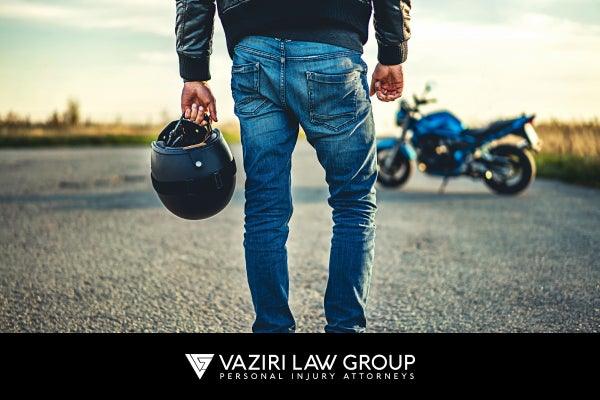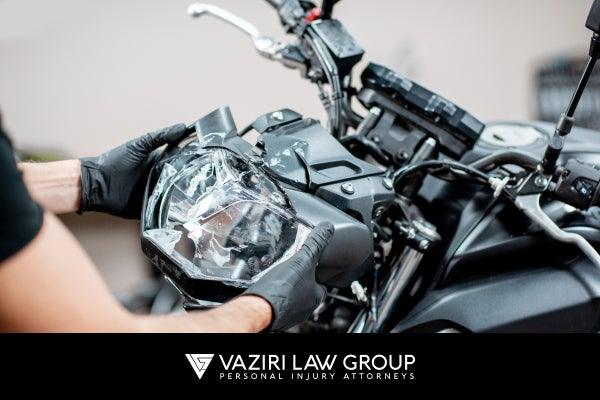
Motorcycle riders in California must follow specific laws to ensure safety and stay in compliance with the law. California has its own set of rules that cover everything from motorcycle licensing to insurance and safety gear. Whether you’re a new rider or an experienced motorcyclist, you must understand the legal requirements for motorcycle riders in the state.
Vaziri Law Group Personal Injury Attorneys helps you understand California motorcycle laws and what you need to do to stay safe on the road. If you’ve been involved in an accident or need advice on motorcycle safety training, we’re here to help guide you through your legal options. Our team is committed to helping you get the justice you deserve.
Motorcycle Licensing Requirements in California
To legally ride a motorcycle in California, you must have a valid California motorcycle license. The state requires all riders to meet certain requirements, including passing a motorcycle knowledge test and motorcycle skills test. Understanding the licensing process is essential to ensure you’re riding legally and safely.
Motorcycle License Types
In California, there are two main types of motorcycle licenses:
- Class M1 License: This license allows you to operate any motorcycle, including motorized bicycles and motor-driven cycles.
- Class M2 License: This license is for riders who only wish to operate motorized bicycles or mopeds.
To obtain a Class M1 or M2 license, you must pass the motorcycle knowledge test and, for the M1 license, the motorcycle skills test. Both tests assess your knowledge of California motorcycle laws and your ability to operate a motorcycle safely.
Steps to Get a Motorcycle License
To get a valid California motorcycle license, you need to follow these steps:
- Complete a Motorcycle Safety Course
- Enroll in a motorcycle safety training course. This is highly recommended and may help you skip the skills test if you complete the course successfully.
- Pass the Motorcycle Knowledge Test
- Take and pass the motorcycle knowledge test. This test covers California motorcycle laws and safety rules for motorcycle riders.
- Schedule a Motorcycle Skills Test
- If you don’t complete the safety course, you must pass the motorcycle skills test. This test ensures you can safely operate a motorcycle.
- Submit Required Documents
- Provide necessary documents, such as proof of identity and residency, and pay the filing fee.
- Pass the Vision Test
- You must pass a simple vision test at the DMV.
By following these steps, you’ll be able to obtain your California motorcycle license and legally ride your motorcycle.
Motorcycle Learner’s Permit
If you’re a new rider, you can apply for a motorcycle learner’s permit in California. This permit allows you to practice riding a motorcycle on public roads under certain conditions, but it comes with restrictions. It’s a great way for beginners to gain experience before applying for a full motorcycle license.
To get a learner’s permit, you must:
- Be at least 15 and a half years old.
- Pass the motorcycle knowledge test.
- Have a valid California driver’s license or instructional permit.
- Follow the restrictions, which include riding only during daylight hours and not carrying passengers.
Once you’ve gained enough experience with the learner’s permit, you can move on to taking the motorcycle skills test or completing a motorcycle safety training course to get your full motorcycle license.
Call our personal
injury lawyers today
Helmet and Safety Gear Laws

California has strict laws regarding motorcycle helmets and other safety gear. Understanding these laws helps ensure you stay safe and comply with California motorcycle laws.
California’s Universal Helmet Law (CVC §27803)
California’s universal helmet law (CVC §27803) requires all motorcycle riders and passengers to wear a helmet that meets specific safety standards. The helmet must be approved by the Department of Transportation (DOT). Riding without a helmet is illegal, and violators can face fines.
The law applies to all riders, regardless of age or experience. Even if you’re just riding for a short distance, wearing a helmet is essential for your safety. Helmets are proven to reduce the risk of head injuries in case of accidents, and wearing one can significantly decrease the chances of severe head injuries.
Always ensure that your helmet is properly fitted and fastened while riding to stay compliant with California law.
Additional Safety Gear Recommendations
In addition to wearing a helmet, California recommends several other pieces of safety gear for motorcycle riders. Wearing the right gear can help protect you in the event of an accident and ensure your safety on the road.
- Gloves: Protect your hands from abrasions and improve your grip on the handlebars.
- Jacket: A protective jacket made of durable material (like leather or textile) can help shield you from road rash and impact.
- Pants: Wear pants made from strong materials, such as jeans or specialized motorcycle pants, to protect your legs.
- Boots: Sturdy boots offer ankle protection and prevent your feet from slipping while riding.
- Reflective gear: Reflective vests or jackets increase visibility to other vehicles, especially at night or in low-visibility conditions.
By wearing the appropriate safety gear, you reduce your chances of injury while riding and stay in compliance with California motorcycle laws.
Lane Splitting Laws in California
Lane splitting is unique to California and allows motorcycle riders to legally ride between lanes of traffic. However, there are specific rules and safety guidelines that every rider must follow to ensure they stay safe and within the law.
Is Lane Splitting Legal?
Yes, lane splitting is legal in California, but it comes with rules. Motorcycle riders can ride between lanes of traffic when cars are stopped or moving slowly, such as in heavy traffic. However, lane splitting should only be done when traffic is moving at speeds of 30 miles per hour or slower, and the rider should not exceed 10 miles per hour faster than the surrounding traffic.
The California Highway Patrol has set guidelines to ensure safety while lane splitting. If done recklessly or in dangerous conditions, lane splitting could result in a citation. Always keep safety in mind and follow the rules when lane splitting to avoid accidents and stay compliant with California motorcycle laws.
Safe Lane Splitting Guidelines
To ensure safety while lane splitting, motorcycle riders should follow certain guidelines. These rules are designed to protect both the rider and other motor vehicles on the road.
- Lane splitting speed: Never split lanes when traffic is moving faster than 30 miles per hour. At speeds above that, lane splitting becomes more dangerous.
- Distance between vehicles: Maintain enough space between your motorcycle and other vehicles. Don’t ride too close to motor vehicles.
- No lane splitting at high speeds: Always keep your speed within 10 miles per hour of the surrounding traffic. Going too fast can increase the risk of accidents.
- Consider road conditions: Only lane split when traffic conditions are ideal. Avoid splitting lanes in poor weather or on roads with tight lanes.
By following these lane-splitting guidelines, you ensure your safety and remain compliant with California motorcycle laws.
personal injury lawyer
get a free consultation
Motorcycle Equipment and Maintenance Laws

California has specific laws regarding motorcycle equipment and maintenance to ensure that motorcycle riders are safe on the road. These laws outline the essential features your motorcycle must have to be legally operated in the state.
Required Equipment for Motorcycles
California law requires that all motorcycles be equipped with the following:
- Working lights: Your motorcycle must have a working headlight, brake light, and turn signals.
- Mirrors: A motorcycle must have at least one mirror, though most have two for increased visibility.
- Brakes: Both front and rear brakes are required for a motorcycle to be roadworthy.
- Tires: Your tires must be in good condition with proper tread depth to ensure safe handling of the bike.
- Horn: A functional horn is required to alert other motor vehicles of your presence.
These requirements ensure that motorcycle riders are visible and have the proper equipment to operate their motorcycles safely.
Handlebar Height Restrictions
In California, motorcycle laws also include regulations about the handlebar height for motorcycles. The height of your handlebars can affect how you control your bike and your safety on the road.
- Handlebar height limit: The handlebars of a motorcycle cannot be more than 6 inches above the rider’s shoulder height when sitting on the bike. This ensures the rider can maintain control of the motorcycle.
- Control and stability: Excessively high handlebars can reduce your ability to control the bike, especially during turns and when riding at high speeds.
By following these California motorcycle laws, you ensure your motorcycle is properly equipped and safe to operate, minimizing the risk of accidents.
Motorcycle Passenger and Insurance Requirements
If you plan to carry a passenger on your motorcycle or you’re riding with a passenger, California has specific laws you need to follow. These laws ensure that both the rider and passenger are protected while on the road.
Rules for Carrying Passengers
In California, motorcycle passenger laws dictate that passengers can only ride on motorcycles if:
- Passenger seat: The motorcycle must be equipped with a proper passenger seat.
- Footrests: There must be footrests for the passenger to use while riding.
- Age limit: Passengers must be old enough to safely sit on the motorcycle and use footrests. Generally, children under the age of 4 are not allowed to ride as passengers on motorcycles unless they are secured in a child safety seat.
These rules ensure that passengers are safely seated and protected during the ride.
Minimum Insurance Requirements
California requires motorcycle riders to have minimum motorcycle insurance coverage. The law requires:
- Liability coverage: You must have at least $15,000 for bodily injury to one person, $30,000 for injury to more than one person, and $5,000 for property damage.
- Proof of insurance: When you’re riding, you must carry proof of your motorcycle insurance.
Having proper motorcycle insurance is not only required by law but also protects you financially if you’re involved in an accident.
DUI Laws for Motorcyclists

In California, motorcycle riders are subject to the same DUI laws as car drivers. Riding under the influence of drugs or alcohol is dangerous and illegal. Understanding these laws helps keep you safe on the road.
DUI Limits and Penalties
Follow California law and avoid riding under the influence to prevent serious consequences.
Motorcycle Sobriety Checkpoints
California law enforcement uses sobriety checkpoints to catch motorcycle riders and other drivers who are under the influence. These checkpoints are typically set up in areas with high traffic volume. During these checkpoints, officers check drivers for signs of intoxication or impairment.
If you’re stopped at a checkpoint, you may be asked to perform field sobriety tests. If you’re caught riding under the influence, you can face DUI charges and the penalties listed above. Remember that motorcycle riders must comply with these laws to avoid legal trouble and stay safe on the road.
California Motorcycle Parking and Road Use Laws
California has specific motorcycle laws regarding parking and where motorcycles are allowed to ride. These rules are designed to ensure safety and efficiency on the road, both for motorcycle riders and other motor vehicles.
Motorcycle Parking Rules
California allows motorcycles to park in certain areas that may not be available for other vehicles. However, there are still rules that must be followed to park legally:
- Parking in designated motorcycle spaces: Motorcycles are allowed to park in spaces marked specifically for motorcycles, even if other vehicles are parked in nearby spots.
- Sidewalk parking: It is illegal to park a motorcycle on sidewalks unless it’s in a designated motorcycle parking space.
- No blocking traffic: Motorcycles should not park in a way that blocks motor vehicles or pedestrian walkways.
By following these parking rules, motorcycle riders help ensure smooth traffic flow and avoid fines.
Where Motorcycles Cannot Ride
While motorcycles are allowed to use most roads, there are restrictions on where they can ride:
- Freeways and highways: Motorcycles are allowed on most freeways, but they must follow all speed limits and traffic rules.
- Bus lanes: Motorcyclists are prohibited from riding in bus-only lanes.
- Restricted areas: Motorcycles may not be allowed in certain areas like private property or restricted zones where motor vehicles cannot enter.
Know the rules about motorcycle road use to avoid accidents and legal issues. By respecting these restrictions, motorcycle riders help maintain safe and efficient road conditions.
personal injury lawyer
get a free consultation
FAQs
Yes, motorcycle training is highly recommended in California. Completing a motorcycle safety course provides valuable skills and knowledge for riding safely. It also helps you pass the motorcycle skills test and may allow you to skip the test if you complete the course successfully. The California motorcycle handbook provides more information on training requirements.
If you’re involved in a motorcycle accident, you should stay calm and check for injuries. Call the police to report the incident and gather information from other parties involved. Contact a motorcycle accident lawyer to discuss your case. They can help you understand your rights and get the compensation you deserve.
The Motorcycle Anti-Tampering Act is a California law that prohibits modifications to motorcycles that could alter their emissions, safety features, or performance in ways that could make them unsafe or illegal to operate.
In California, motorcycle lane splitting is allowed, but motorcycles cannot ride side by side in the same lane unless it’s for lane splitting under the specific guidelines outlined by the California Highway Patrol. Always make sure to follow the rules to stay safe.
Yes, you must pass a driver knowledge test as part of the process to obtain a motorcycle license. This test covers important California motorcycle laws and safety rules. It is essential to study the California motorcycle handbook before taking the test to ensure you understand the rules of the road.
Contact Our Motorcycle Accident Lawyer for a Free Case Consultation

If you’ve been involved in a motorcycle accident, you may be entitled to compensation for your injuries and losses. Vaziri Law Group Personal Injury Attorneys specializes in handling motorcycle accident cases and can help you through the legal process. We understand the complexities of California motorcycle laws and will work tirelessly to protect your rights.
Our team can assist with gathering evidence, negotiating with insurance companies, and advocating on your behalf in court if needed. We offer a free consultation to discuss your case and explain your legal options. If you’ve been injured in a motorcycle accident, don’t hesitate to reach out to us. We’ll help you understand your rights, the motorcycle training and safety laws that apply, and how to seek the compensation you deserve.
Contact us today for your free case consultation. Let us help you get the justice and financial relief you need after an accident.